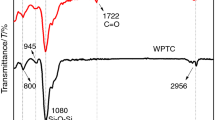Abstract
The environmental stability of sol-gel anti-reflection (AR) coatings on optical components is improved by an exposition to volumetric concentrated ammonia vapors. Coatings of 86 nm thickness are prepared by dip-coating in the silica sol synthesized by hydrolysis and condensation of tetraethyl orthosilicate (TEOS) in the ethanol solvents with a base catalyst. Due to the sol-gel process, the coatings have a large micro-porosity and consequently susceptible to contamination by adsorbing volatile organic compounds in the vacuum environment of high-powered lasers. The ammonia vapor (NH3) followed by hexamethyldisilazene (HMDS) vapor respectively at room temperature is used to reduce the susceptibility. This work presents how the concentration of NH3 vapor exposed to the coatings affects the environmental stability regarding to the optical performance, and shows that NH3 vapor treatment with volumetric concentration of at least 10 vol% can make the coatings substantially durable, combined with excess HMDS vapor treatment both for 24 h. Besides, different off-line methods of cleaning to remove the deposition of the vapor contamination within the coatings, including infrared heating, ethanol dipping, and plasma cleaning, are investigated and compared.

Graphical abstract
Highlights
-
Compared the NH3 treatment alone and HMDS treatment alone to the sol-gel AR coating, proving NH3 treatment dominants the contamination resistance.
-
Analyzed the effects of volumetric concentration of vapor NH3 treatment on the environmental stability of the sol-gel AR coatings systematically.
-
The least volumetric concentration of NH3 vapor exposed to the sol-gel AR coating to achieve substantially environmental stability is 10 vol%.
-
The effectiveness of three methods of off-line cleaning the contamination within the sol-gel AR coatings is verified.







Similar content being viewed by others
References
Thomas IM, Burnham AK, Ertel JR, Frieders SC (1998) Method for reducing the effect of environmental contamination of sol-gel optical coatings. Proc SPIE - Int Soc Optical Eng 3492:220–229
Atherton J (1999) Improved antireflection coatings for the NIF. Inertial Confinement Fusion Quarterly Report 9(2):163–176
Li X, Shen J (2011) The stability of sol–gel silica coatings in vacuum with organic contaminants. J Sol-Gel Sci Technol 59(3):539–545
Boscher C, Avice J, Belleville P, Piombini H, Vallé K (2017) Study of the sol-gel thin-film ammonia curing process. Instrum Mes Metrologie 16(1-4):165
Belleville PF, Floch HG (1994) Ammonia hardening of porous silica antireflective coatings. Proc SPIE 2288:25–32
Vicente GS, Bayon R, German N, Morales A (2011) Surface modification of porous antireflective coatings for solar glass covers. Sol Energy 85(4):676–680
Favrat O, Mangote B, Tovena-Pécault I, Néauport J (2014) Study of organic contamination induced by outgassing materials. Application to the Laser MégaJoule optics. Appl Surf Sci 293:132–137
Sun J, Zhang Q, Ding R, Lv H, Yan H, Yuan X, Xu Y (2014) Contamination-resistant silica antireflective coating with closed ordered mesopores. Phys Chem Chem Phys 16(31):16684–16693
Hui-Yue Z, Xiao-Dong W, Jian-Bin F, Yuan L, Jun S (2018) Environmental stable SiO2 antireflective coating modified via NH3 /HTMS vapor phase treatment. J Inorg Mater 33(11):1219
Yuan L, Shen J, Wu G, Zhou B, Zhang Z (2012) Effect of ammonia treatment time on contamination resistant capability of SiO2 AR coatings. Rare Met Mater Eng 41(11):331–334
Xu Y, Lei Z, Dong W, Yu HS, Zhong HW (2005) Durable solgel antireflective films with high laser-induced damage thresholds for inertial confinement fusion. J Opt Soc Am B 22(4):905–912
Zhang QZQ, Zhou LZL, Yang WYW, Hui HHH, Xu QXQ (2014) Sol-gel preparation of a silica antireflective coating with enhanced hydrophobicity and optical stability in vacuum. Chin Opt Lett 12(7):071601–071604
Songnan Z, Haibing L, Lianghong Y, Haijun W, Tao W, Xiaodong Y, Wanguo Z (2010) Contamination-resistant capability of sol-gel fluorin-doped SiO2 antireflective coating in vaccum. High Power Laser and Part Beams 22(5):1065–1068
Marshall KL, Rapson V, Zhang Y, Mitchell G, Rigatti A Contaminant Resistant Sol-Gel Coatings for High Peak Power Laser Applications. Optical Interference Coatings, Tucson, Arizona, 2007/06/03 2007. OSA Technical Digest (CD). Optical Society of America, p FB7. https://doi.org/10.1364/OIC.2007.FB7
Sun J, Wu B, Jia H, Wu D, Xu Y (2012) Fluoroalkyl-grafted mesoporous silica antireflective films with enhanced stability in vacuum. Opt Lett 37(19):4095–4097
Wang J, Guo N, Zhang J, Liao W, Xiang X, Jiang X (2019) Removal of particle contaminations on sol-gel coated fused silica surface by laser cleaning. Pacific Rim Laser Damage: Optical Materials for High-Power Lasers. International Society for Opticsand Photonics 11063:110630B
Liu H, Miao X, Yang K, Lv H, Zou R, Zhou G, Cheng X, Yang H, Yuan X, Jia B (2015) Atmosphere pressure plasma cleaning of grease contamination on sol-gel SiO2 coating. High Power Laser and Particle Beams 27(11):112008
Miller P, Thorsness C, Ertel J, Behne D, Kishiyama K (2014) Use of Silica Gel as a Getter for the Protection of Sol-gel Coated Optics: Concept Verification. Lawrence Livermore National Lab.(LLNL), Livermore, CA (United States)
Acknowledgements
This work was supported by National Natural Science Foundation of China (Grant No. 22072139).
Author information
Authors and Affiliations
Corresponding author
Ethics declarations
Conflict of interest
The authors declare no competing interests.
Additional information
Publisher’s note Springer Nature remains neutral with regard to jurisdictional claims in published maps and institutional affiliations.
Rights and permissions
About this article
Cite this article
Huang, L., Yan, H., Yan, L. et al. Improvement of the environmental stability of sol-gel silica anti-reflection coatings. J Sol-Gel Sci Technol 101, 630–636 (2022). https://doi.org/10.1007/s10971-022-05725-z
Received:
Accepted:
Published:
Issue Date:
DOI: https://doi.org/10.1007/s10971-022-05725-z




